Do people know where their chicken comes from?
- Published
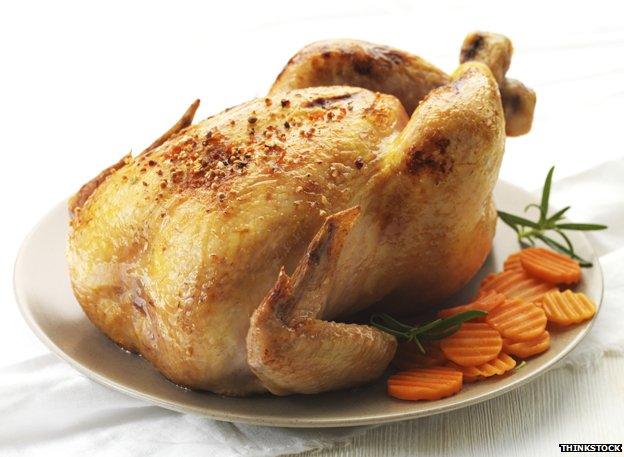
Campaigners say chicken meat needs better labelling. How much do people really know about the life of a chicken before it reaches their plate?
A long, low, metal shed, fed by large plastic drums, pipes and chimneys - to the layman it looks like a small chemical plant. Hidden in the folds of the Peak District, it's an incongruous sight. The only hint that living things are housed inside is the pungent smell from the extractor fan - like a mixture of a pet shop and manure.
The facility is not a paint or fertiliser factory. It is called Lower Farm and produces chickens. In a period of between 33 and 38 days, the chicks grow to an average weight of 2.2kg - ready to be slaughtered. Lower Farm, just outside Chesterfield, is not what most of us would think of as a farm. It is run by a poultry company called Applied Group, which operates two other farms. The chickens never go outside. Everything happens in four large sheds. The interiors of the sheds are continuously filmed and key statistics recorded - every litre the birds drink, every 10kg of feed that has been dispatched by the feeder mechanism, how much the birds weigh. Lower Farm produces 1.25 million chickens a year.
Nearly all chicken meat eaten in the UK comes from a place like Lower Farm. "This intensive chicken farming goes on behind closed doors," says Dil Peeling, campaigns director at charity Compassion in World Farming (CWF) . "It's hidden from people. They still have this image of chickens scratching around in a farmyard."

Chickens in a Cumbrian rearing shed
Free-range accounts for 5% and organic 1% of UK chicken production, according to the British Poultry Council. The remaining 94% comes from intensively reared birds.
This is in stark contrast to eggs, where free-range and organic together make up 45% of UK production, external. Of the eggs bought in shops by consumers - as opposed to eggs used in processed food - free-range is now half of the market, external.
Egg-buying habits have changed radically. Farmers respond to consumer demand and free-range eggs accounted for just 11% of production in 1994. Ten years ago it was still only 27%. There's been no such shift on meat chickens. It's not uncommon to see free-range eggs advertised in sandwiches. Pret A Manger uses them. But its chicken sandwiches are not free-range but "higher welfare", external indoor-reared chicken.
Egg production and chicken meat are separate industries. Since the 1950s two distinct chickens have been bred by the farming industry - laying hens for eggs and broiler chickens for meat. Sophisticated breeding means that every year a broiler chicken lives one day less to deliver the same weight of food, the RSPCA estimates.
They may be separate industries, but why do so many more people buy free-range eggs than free-range chickens? CWF recently ran a 39-day campaign, external - the average lifespan of an intensive broiler - to call for a chicken's method of production to be clearly labelled.
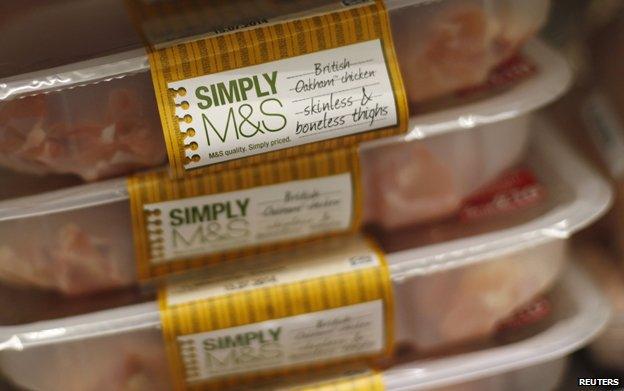
There is a significant price difference between the cheapest and the most expensive chicken
Cost is probably the main reason. There is a bigger price hike in free-range for chicken meat than for eggs. At Sainsbury's, breast fillets - the most commonly bought chicken - vary from £6.95 per kg for Basics fillet portions, to £12.99 for standard, to £14.95 for free-range, to £19 for organic free-range.
Excluding the fillet portions, there is still a difference of almost £2 per kg between intensive and free-range, and more than £6 per kg between intensive and organic. Six Basics eggs cost 90p, while half-a-dozen free-range eggs cost £1.35 and organic £2. This means it costs 50% more for free-range eggs - a significant price hike.
But because eggs are fairly cheap items, it perhaps doesn't seem so bad, just an extra 45p to go for free-range. Opting for free-range chicken breasts works out at £1.96 more expensive. "You've probably got to be quite committed to trade up for meat - not to mention affluent - but the difference in eggs isn't so painful to the pocket," says Richard Griffiths, director of policy at the British Poultry Council.

Chicken statistics
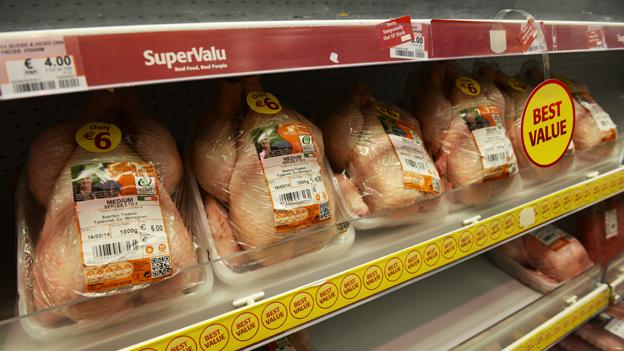
50 billion chickens worldwide
116 million broilers in the UK and 29 million laying hens
750 million broilers slaughtered annually in the UK
Sources: CWF, Defra, external

In the egg industry, battery farming was so widely condemned that the practice was banned in January 2012. Some food commentators argue that consumers would not buy cheap chicken if they could see how it was produced.
Much of the poultry industry is nervous about arranging visits to farm - few ever get to see inside chicken sheds. After prolonged dialogue with the British Poultry Council, a visit is finally arranged to Lower Farm.
So what is it really like?
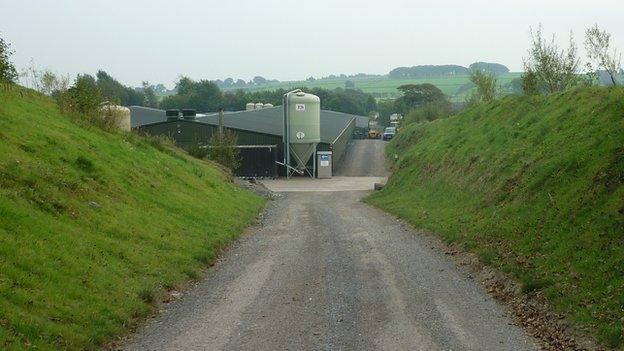
The approach to Lower Farm
In the outer buildings, the first door leads to the control room. Farmer David Speller points at a TV screen with multiple CCTV camera views. One shows the shed we're about to visit and lists key information that is constantly updated. There are 33,426 chickens inside. Until a day ago there had been 45,000 birds but 30% have been taken to slaughter. The remaining chickens are aged 34 days. The temperature is 23.8C, and 159,000 cubic metres of air are being passed through an hour.
Push open the door and for a second it's not immediately apparent what the moving creamy white mass at your feet is. Then you make out the individual birds. The shed is huge - 100m long and 23m wide. In the soft light, a sea of chickens stretches as far as the eye can see. It's not the grim battery environment some might imagine.
There's natural light coming in through windows on the sides of the shed. The chickens can move around. Their constant chatter is calm and rather soothing. As we walk through, the chickens part slowly. There's no sense of panic or discomfort. They give you a few feet of space then carry on with what they're doing - sitting, milling around, eating or drinking.
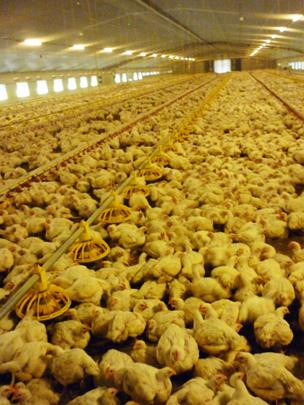
Lower Farm produces 1.25m chickens a year
The ground is soft - a mix of sawdust and faeces. Underneath that is concrete and below that underfloor heating. It's incredibly efficient. Each shed has seven cycles of chickens a year, producing about 310,000 birds each. During rearing, some 3.3% of the total birds die of natural causes.
After each cycle the chicken faeces and sawdust has to be cleaned out and the whole place disinfected. The shed is divided into aisles, about two or three metres apart, of automated feeders and drinkers, giving the birds constant access to feed pellets and water. At one point there's a loud clanking as the feeders are restocked - the chickens rush forward and cluck louder. They eat more when the feed trays have been topped up, says Speller.
It is only after 10 minutes or so that the smell becomes uncomfortable - catching in the throat. It's the ammonia from the chicken faeces. Later I'll notice that my clothes are suffused with the smell of chicken faeces even though I was wearing overalls in the shed. The shed is ventilated to prevent dangerous levels of gases. Speller and his colleague say they are used to it. "We've monitored levels of ammonia, CO2 and other gases and actually it isn't very high," says Speller. "But it is a different type of smell."
There are just a few gaps between the chickens. That's after 30% of the birds have been removed in the past 24 hours, so it must be crowded when full. It's legal though. The maximum allowed under EU rules is 42kg/sq m of chicken. The UK sets a stricter limit of 39kg/sq m and the Red Tractor scheme followed by 90% of intensive chicken farms states that farmers must not exceed 38kg/sq m. With the average chicken being slaughtered at about 2.2kg that equates to roughly 17 chickens per square metre.

What labelling means

An organically raised chicken must be able to get outside for at least a third of its life
Indoor: UK has a maximum stocking density of 39kg/sq m, compared to an EU limit of 42kg/sq m. Most of UK's intensive chicken farmers are signed up to the Red Tractor scheme, which sets the limit at 38kg/sq m (about 17 or 18 birds). Currently no requirement for natural light in barn, although this may be introduced in the future; slaughter takes place between 33-38 days of age, depending on the size of bird required.
Free-range: Maximum stocking density is 27.5kg/sq m (no more than about 12 or 13 birds). Birds must have access to going outside for at least half of their life; outdoor space to allow 1 sq m per chicken. Farmers to encourage birds to roam around and use outdoor space by creating properly managed vegetation, whole grain feeding, water and overhead cover. Slaughter age is a minimum of 56 days.
Organic: EU maximum density for organic is 21kg/sq m (about 10 birds), maximum flock size 4,800 birds. In the UK 70% of organic produce is regulated by the Soil Association, which limits flock size to 1,000 birds. Outdoor space for organic production is 4 sq m/bird, and they must be able to get outside for at least one third of their life. They must also have continuous and easy daytime access to outdoor pasture or range covered with suitable vegetation; slaughter age is minimum of 81 days.
Freedom Food: Welfare scheme that can apply to indoor, free-range or organic chickens. Maximum density 30kg/sq m (about 13 or 14 birds), and there must be access to natural light. For every 1,000 birds the following must be provided: 1.5 straw bales, a 2m perch space and one pecking object. The breed is examined to determine its acceptability for use under RSPCA standards.

Speller says he operates at 36kg/sq m. It's only at the end when the chickens are almost ready for the plate that space becomes tight, he says. In any case, they are used to it, he says. "It's all they've known." And to be fair, they don't look unduly bothered.
The sun is shining outside - is he not tempted to let them out for a wander? He laughs. The birds wouldn't survive most of the year on the Derbyshire hills, he says.
Genetically some free-range birds are not that different, he says, although their ability to peck around in the dirt may give them a different taste. "If it's outside eating worms, spiders, ladybirds and beetles it may well taste different," he says. Indoor birds cannot be fed animal protein.
But it just isn't realistic to let animals loose like this if you want efficient production, he says. "Can we produce a nutritious animal protein meal on your plate for £3.50 or £4 a bird that will feed four people and probably do you a sandwich the next day? To do that and not have this level of control and sophistication is near impossible."
As a farmer you have to know what they're eating and drinking, be monitoring their health, and protect them from bugs and bacteria outside, he says. The margins are so tight now. His predecessor at the farm could pay for a barn in two cycles worth of chickens. The cycles were twice as long then, he adds. Now it takes Speller 60 cycles. The price of chicken is far lower and the cost of the hi-tech sheds much higher.
Chicken is big business. The US writer Jonathan Safran Foer, author of Eating Animals, points out that animal protein has never been cheaper. Americans now eat 150 times as many chickens as they did 80 years ago. If China and India catch up with US consumption, the number of intensively reared birds will reach 100 billion a year.

More than half of chicken in the UK is sold as breast
In the UK, chicken is about 46% of the protein consumed by the average person. More than half (55%) of chicken is sold as breast, 25% as whole birds and the rest - thighs, drumsticks, wings and mince - is 20%.
Tom Wornham, a poultry farmer in Hertfordshire, says people have unrealistic expectations. "How on earth are we going to get protein on the plate unless we do it in an organised fashion?" His chickens have to reach a weight of either 1.9kg or 2.4kg in a period of 49 days. He uses a stocking density of 32kg of chicken per square metre - about 15 chickens by the time they are slaughtered.
He provides bales of straw and pecking objects for the chickens - not a legal requirement. He has a mortality rate of 2.5% and says it's awful having to collect the dead birds. But he doesn't believe the system is cruel.
"As an industry we have to compromise on what's ideal and what is practical to feed the nation," he says. He could use slower-growing birds but doubts there is a huge demand for it. "Would you be happy to pay double the amount so the chicken can live twice as long?" he says.
In the UK, high-profile campaigns led by Hugh Fearnley-Whittingstall and Jamie Oliver have backed free-range chicken, but consumption is still very low.
Last year a survey of European consumers, external suggested that two-thirds of them wanted poultry to get the same kind of labelling as eggs.
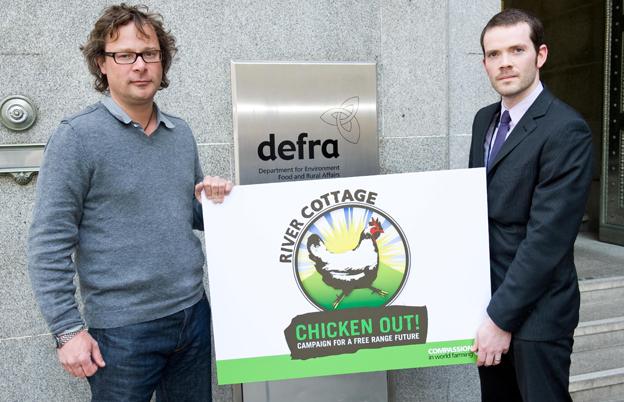
Cookery writer Hugh Fearnley-Whittingstall (left) has campaigned for better poultry conditions
But consumers don't always practise what they preach, especially when presented with a £3 chicken. American writer Michael Pollan, author of The Omnivore's Dilemma, has written that "eating industrial meat takes an almost heroic act of not knowing, or, now forgetting". Deep down, he appears to suggest, most people prefer not to know.
Some think the problem is one of language. The formulation "pink slime" severely damaged the "lean beef trimmings" industry in the US.
It was only in 2004 when the European Commission made it mandatory to label eggs as coming from "caged hens", that battery chickens fell out of favour - they have now been banned. "I'd like to put words like 'industrial' and 'indoors' on the label," says Compassion in World Farming's Peeling. At the moment it's common to see chicken in the UK labelled "farm fresh" or "premium chicken" - terms that even the British Poultry Council admits have no meaning. In the US the situation is worse, he says - one company trumpets its cage-free chicken, which is "ludicrous because no poultry meat is kept in cages".
Food writer Joanna Blythman believes that most consumers wouldn't eat an intensively produced chicken if they saw how the bird was reared. The smell, the crowding, the genetic speeding-up of a bird's life, the breast-heavy breeds - there are many things that upset people about intensive poultry.
But because they are unaware, they follow a "safety in numbers philosophy", she argues. The attitude is: "If this is the normal thing then it must be fine. I don't want to think too much about it." Consumers need to assume that unless high welfare standards are on the label, it will be factory farmed, she says.
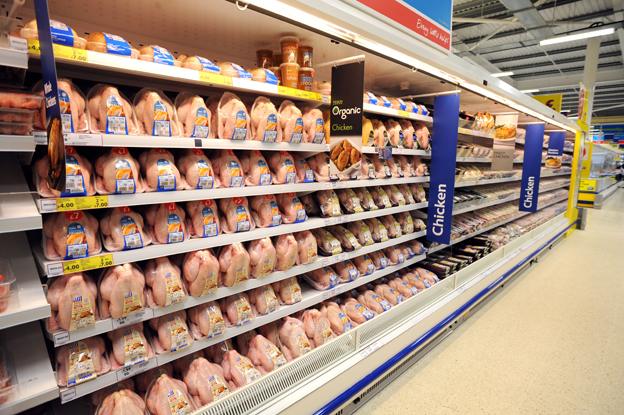
Speller is one of the few intensive broiler farmers to welcome visits and is passionate about opening up chicken sheds to journalists and the public. "It's not something everyone sees. There should be more of it, there should be more school trips to farms. Let the consumer decide."
But he acknowledges that there are contradictions, and questions whether people want to know how their Sunday roast was reared. But one thing people do want to think about is price. He says that there was a 5% decline in fresh poultry sales in January-May this year when production costs rose. "It's very price sensitive," he concludes.
Subscribe to the BBC News Magazine's email newsletter to get articles sent to your inbox.